“Under the Twin Moons” picks up the chase where “Red Directive” left off: Discovery and the Antares in dry dock undergoing repairs after the incredible avalanche stunt on Q’Mal, and their two captains each trying to figure out what, exactly, their purpose is.
Captain Burnham’s (Sonequa Martin-Green) immediate purpose, as it turns out, is to testify in an emergency hearing investigating Rayner actions on Q’Mal. Okay I guess, but isn’t this kind of… square? of the Federation? It’s been established that the 32nd century Federation is a little dorkier than previous eras; a little more “Let’s loop in the stakeholder and set down our key performance indicators” about their approach to diplomacy.
I accept this. But getting a hearing one day after an event that took place half a quadrant away, with the president of the entire Federation presiding, and over something that the member of Starfleet didn’t even actually do is a little much even for these nerds. Surely President Rillak (Chelah Horsdahl) has better things to be doing.
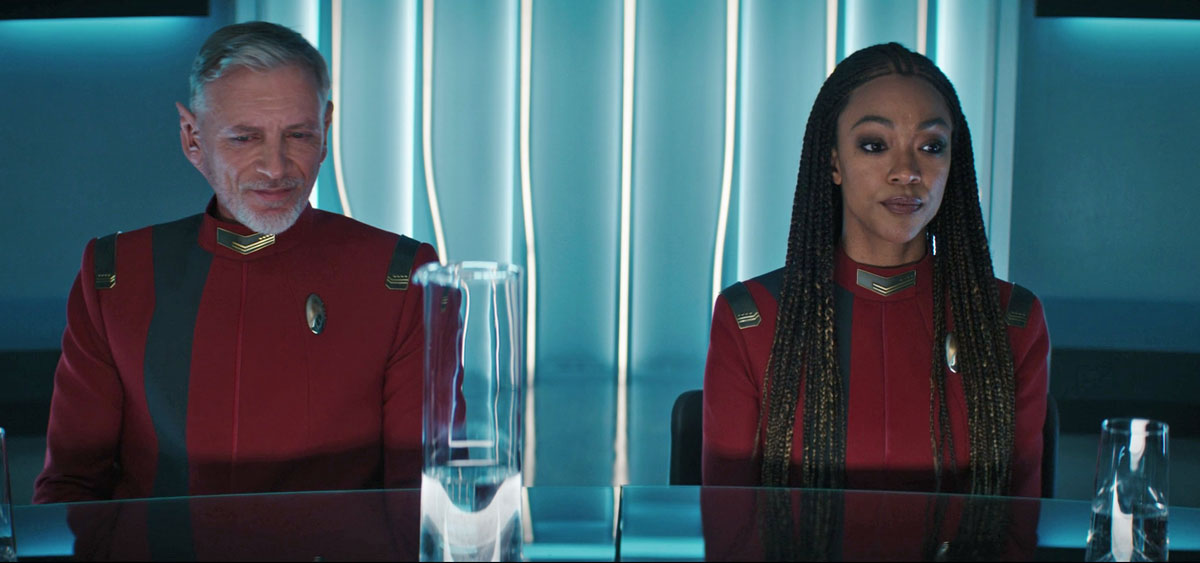
Yes, the hearing is, at its core, a bit silly — Captain Rayner (Callum Keith Rennie) is being reprimanded for… *checks notes* …giving someone else an idea. But if the timeline were stretched a little it would go a long way toward believability. At the end of “Red Directive”, we learn during Burnham’s conversation with Vance that everything at Q’Mal happened earlier that day — and the events of “Under the Twin Moons” also happen in just one single day, if Burnham’s statement about Saru’s last day aboard Discovery is to be taken literally.
Through no fault of the characters themselves, they now find themselves living in a world in which galaxy-spanning events happen within just a few hours of each other. The incredible technology of the 32nd century has rendered time and space essentially obsolete, and that… well, that kinda sucks for the gravity of the storytelling.
We don’t stick around for the conclusion of the hearing because Discovery’s repairs are complete — that is to say, the DOTs are done dusting off the hull — and there’s still that urgent mystery to solve. Unsurprisingly, Book (David Ajala) will be traveling with Discovery for the rest of the mission since his experience as a courier will come in handy in the chase after Mol (Eve Harlow) and L’ak (Elias Toufexis), and Tilly (Mary Wiseman) tags along for the day too, since it’s always good to have another scientist around.
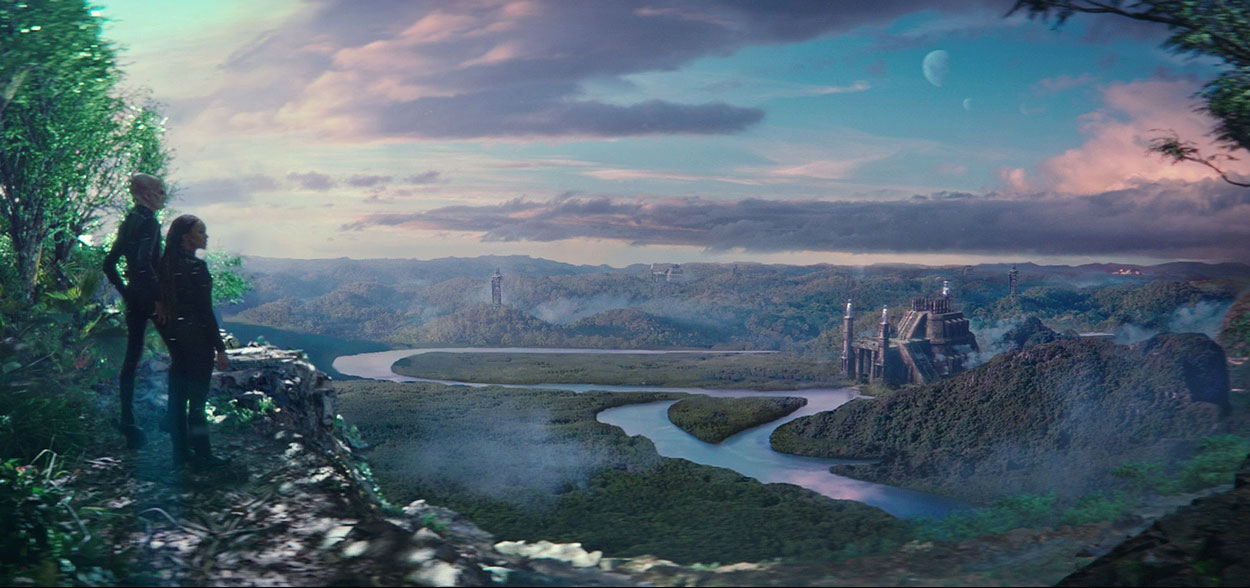
Discovery arrives at V’Leen, an M-class planet dotted with necropolises and other sacred sites left by the warlike and long-extinct Promellians (introduced in TNG’s “Booby Trap”). The specific necropolis — and the specific area within that necropolis — that Vellek indicated in his notebook is quickly identified, because it’s where the eclipse would pass.
I’m not sure how well “Under the shadow of twin moons” really works as a clue here. Eclipses are roving phenomena, the path of totality cutting a swath across a planet’s surface. While predictable, it changes from eclipse to eclipse due to the relative orbital and rotational movement of the bodies creating the eclipse. Cleveland, Ohio, will be in the path of totality of the April 8th solar eclipse, but that fact isn’t a good way to uniquely identify it to someone 800 years from now! Everywhere on a planet is within a certain latitudinal boundary is within the path of an eclipse at some point or another.
Anyway, Burnham and Saru (Doug Jones) identify a target location, then beam down as close to it as they can. Unfortunately, because of an unusually strong electrical field emanating from the necropolis, they have quite a hike ahead of them. Fortunately for us, this means we get a nice long shot of the necropolis in the distance, rising through the jungle in the valley below, two crescent moons hanging in a purple sky. I don’t know if this was an intentional nod to the matte paintings of yesteryear, but if so then it’s a nice one.
As one would expect from Promellians, V’Leen is booby trapped. Saru and Burnham’s nice trek through the jungle is rudely interrupted when an ancient sentry system is activated, and a seemingly endless supply of attack drones pop out of the eyes of one of the many fallen statues that litter the area. Saru and Burnham are pinned down, so it’s up to Tilly and Adira (Blu del Barrio) aboard Discovery to figure out a plan.
This is where things get tricky.
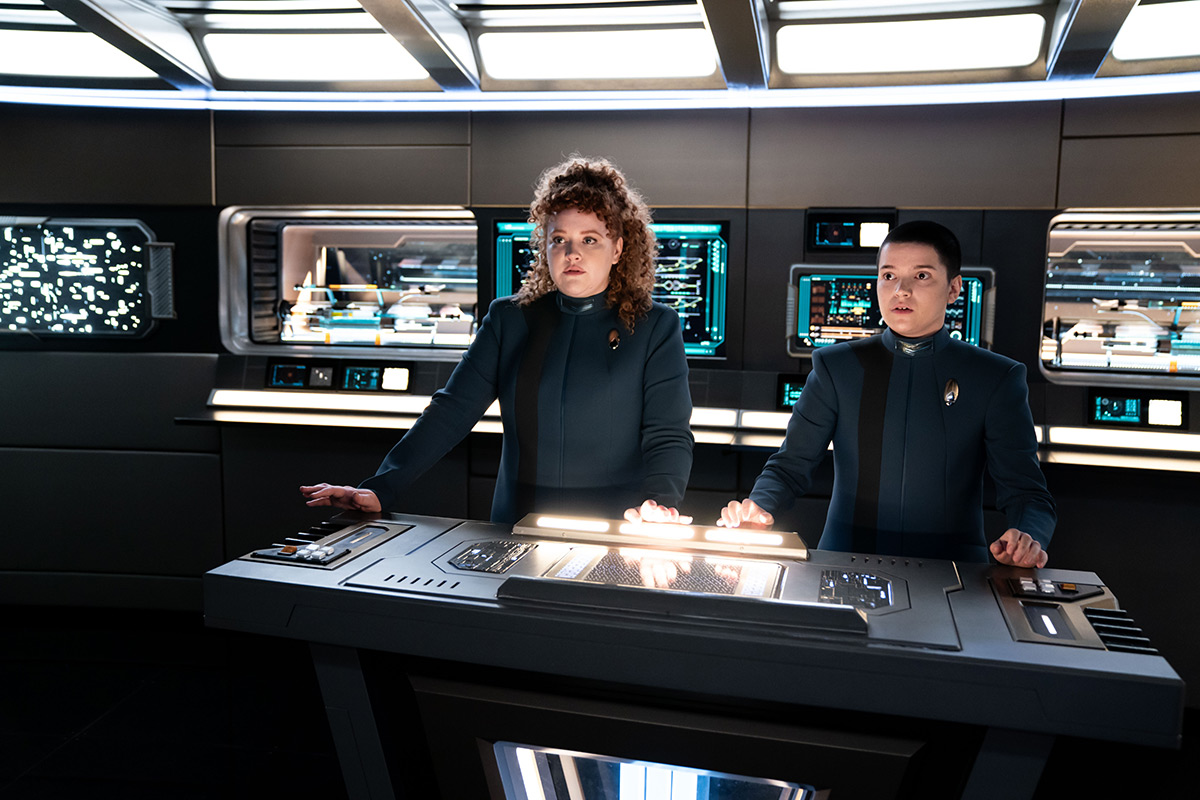
Discovery — along with Strange New Worlds and Picard — sometimes hits against a specific challenge of making Star Trek in the 2020s: balancing the technobabble-heavy “thinking out loud” problem solving that Star Trek has been doing since the 1960s (but really perfected in the 1990s) with the faster pacing and heightened stakes demanded of contemporary television. Taking just the dialogue of this scene, it’s perfectly good Star Trek-y problem solving. Taking just the pacing and action, it’s a perfectly good “Oh shit, how are we gonna get out of this?!” situation. But putting them together, I’m not sure it works.
It’s not that there’s too much conversation as they try to work out how not to be killed, it’s that stylistically the conversation no longer fits the action. In the slower pacing of The Next Generation’s era of television, the technobabble feels like the means to the solution instead of a hindrance to it. In past iterations of Star Trek, even when Geordi or B’Elanna or whoever was “tech-ing the tech” that week weren’t sure that something was going to work, their idea still felt like a critical piece of the puzzle that only they could come up with.
On Discovery, between the pseudo-magical 32nd century technology — and the fact that some of our heroes missed 800 years of history class — Adira and Tilly’s problem solving feels like the least important contribution to the process. Yikes.
It’s hard to tell a satisfying story when the characters themselves seem extraneous within it because, through no fault of their own, they are the slowest and least capable thing about the world which they inhabit.
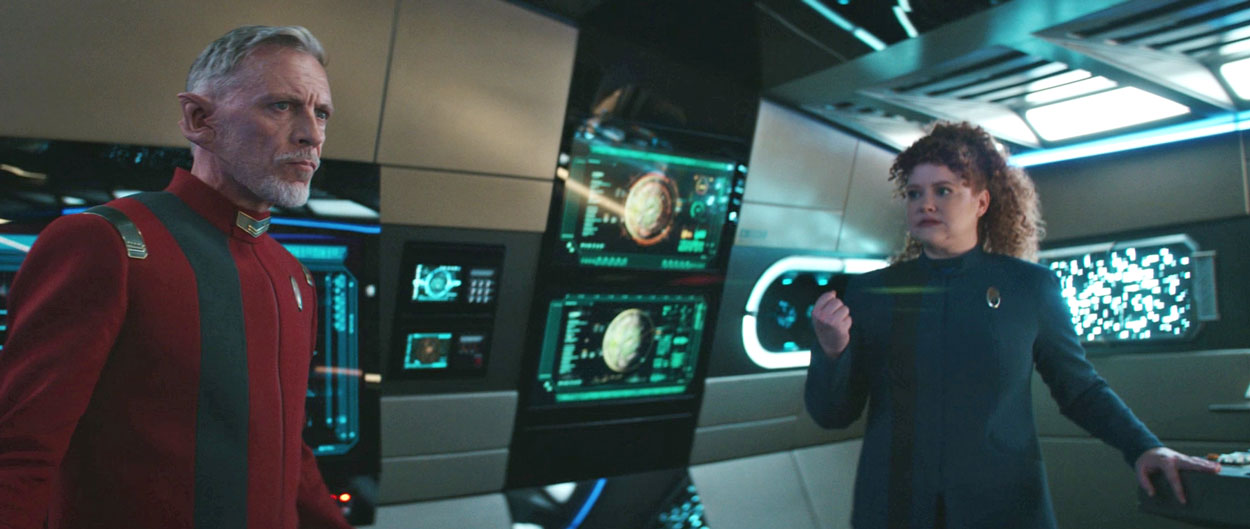
But Adira and Tilly do figure it out when Rayner shows up — holographically, because again, space and time have no meaning anymore and anyone can be anywhere at any time, it seems. Smartly (and a little sharply), he suggests they use appropriate historical knowledge instead of leaping straight to the high-end theoretical physics.
The solution ends up being a fairly simple one, the good old standby of “set your phaser to overload and put it next to something.” The only question is who’s going to do it — and who’s going to take on the much more dangerous task of drawing fire? Saru insists because as a Kelpien he’s much faster and heartier, but Burnham is, to put it mildly, not a fan. Saru is proverbially one day from retirement and besides, he’s about to be married — though no word on whether he’s getting too old for this shit. But today is not a day for action movie clichés and “Action Saru” lives to tell the tale.
Burnham and Saru eventually make it to the center of the necropolis, and what they find waiting for them isn’t the progenitors’ technology, but another clue, this time a Romulan poem carved into a standing stone. Mol and L’ak, it seems, did get to V’Leen first (defacing the poem before they left), but Burnham and Saru see past their efforts and find the needed clue — sending them to the Trill homeworld. (As with the false warp signatures, Mol and L’ak really don’t have good luck with their attempts at sabotage.)
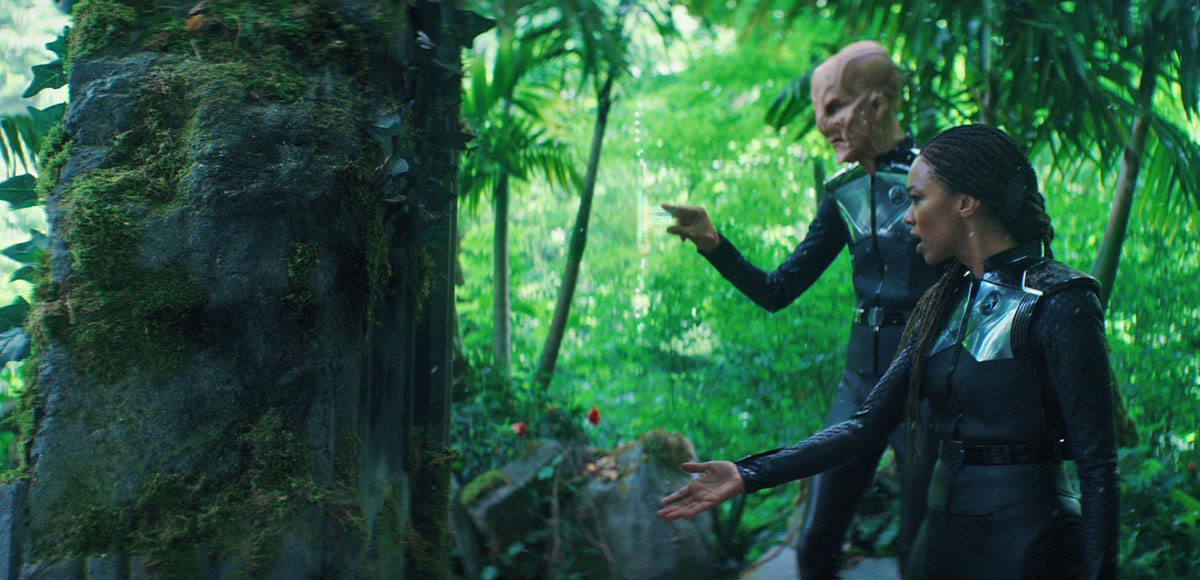
Back aboard Discovery, it’s determined that the doo-dad (official scientific term) fits into one of the sections of a conspicuous circular design Vellek drew in his notebook, and all agree that it’s the beginning of a three-dimensional map. Neat!
Following the next lead to Trill will give us an opportunity to check in on Adira and Gray’s (Ian Alexander) relationship, but I’m also hoping the show will use this chance to explore more of what it means for Adira — a human — to be joined with a Trill symbiont. When Adira was first introduced this was the hook for their character, and it’s a really interesting idea that has been essentially forgotten once Gray’s lingering consciousness was removed.
Given what we’ve seen of other Trill and their complex relationship with their symbionts’ past lives and their own host-hood (especially when being a host isn’t something they’ve trained for), it’s hard to believe that Adira wouldn’t have any continuing thoughts on the matter. I hope this is revisited next week, even if only briefly.
While Burnham and Saru were checking out V’Leen, Book had been working with Culber (Wilson Cruz) and Stamets (Anthony Rapp) to try and learn more about Mol and L’ak. He decides to try contacting them over “dark comms” — which sounds like the dark web, and thus a little silly — and, happy for us, they answer (but not before Stamets gripes that “it doesn’t appear to be working” immediately after Book sends the hail. It’s been one whole second, take a breath, they might be in the bathroom or something!).
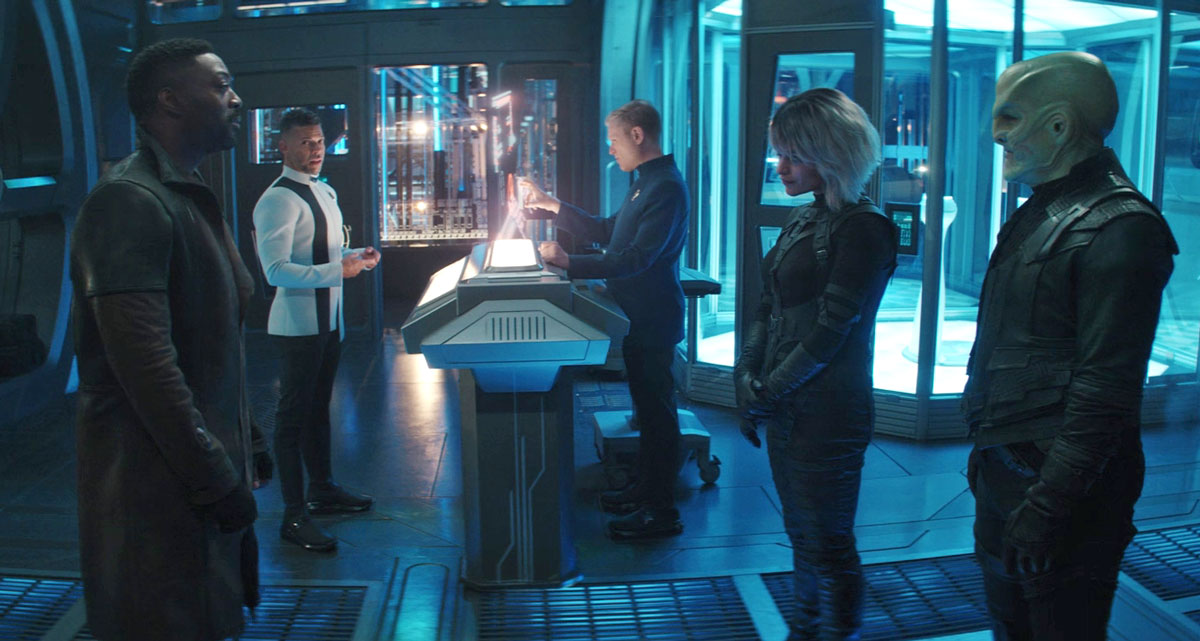
The conversation between Book, Mol, and L’ak is pretty anticlimactic, to be completely honest. Mol postures a lot, L’ak doesn’t say much, and Book plays it cool. The one bit of information Moll gives about herself is just a look, a reaction, to Book’s name. This jogs something in Book who, afterwards, puts it all together and realizes that Mol is actually Malinne Ravel, the daughter of his mentor, the previous Cleveland Booker. He’d never met Malinne, but he’d seen her picture and he decides that she’s the closest thing he has to family.
I mean, is she? Does she want to be? This seems like a lot to put on someone to whom you’re a total stranger.
OBSERVATION LOUNGE
- We have our first stardate of the season: 866274.3.
- Some of the background extras at Starfleet Command are still wearing the mostly-grey Season 3 uniforms, with a solid-color jacket stripe. (Continuing to use old costumes is a longtime Star Trek budget-saving tradition!)
- Zora notes that the Promellians used Lang Cycle fusion drives to power their ships, a fact established in “Booby Trap.”
- Saru remembers that Romulan homes often had a false front door (or shaipouin), a notion first introduced into Trek canon through Soji Asha in Star Trek: Picard’s “The End is the Beginning.”
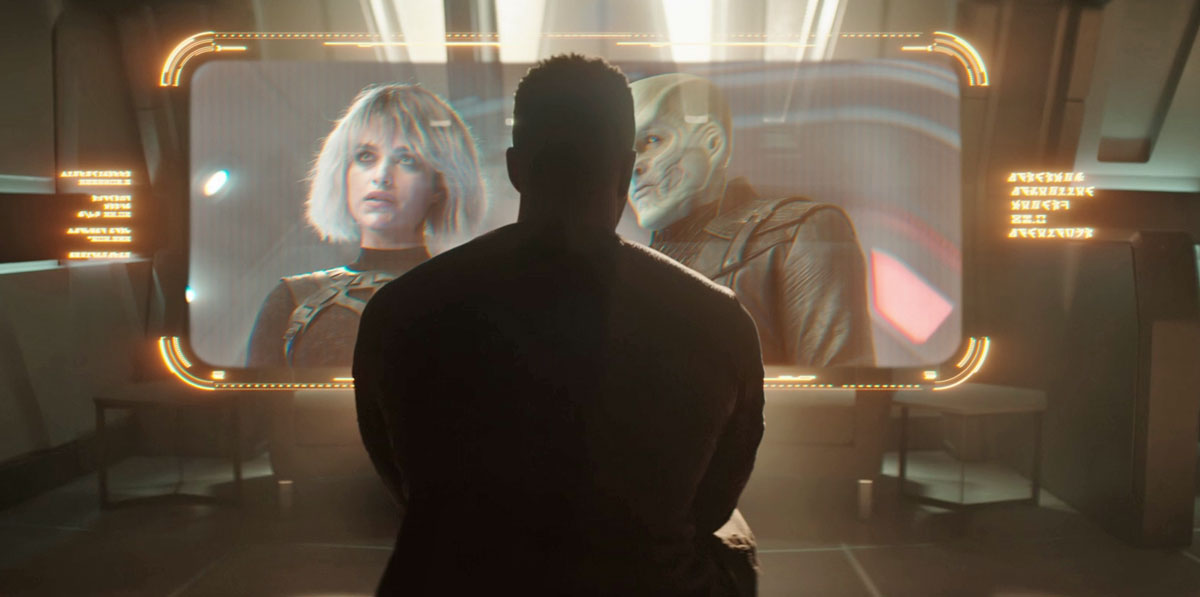
- Mol and L’ak projected themselves as 3D holograms into Discovery’s engineering bay… so why does book need to play back a recording of their conversation on a 2D holographic display?
- Despite Saru’s departure, Burnham promises that his special ‘greenhouse’ quarters will remain a Kelpien arboretum.
- Admiral Charles Vance’s daughter is named Charlie; named for her father no doubt!
- Rayner’s been awarded with distinguished service citations, awards of valor, and the Grankite Order of Tactics — just like Jim Kirk.
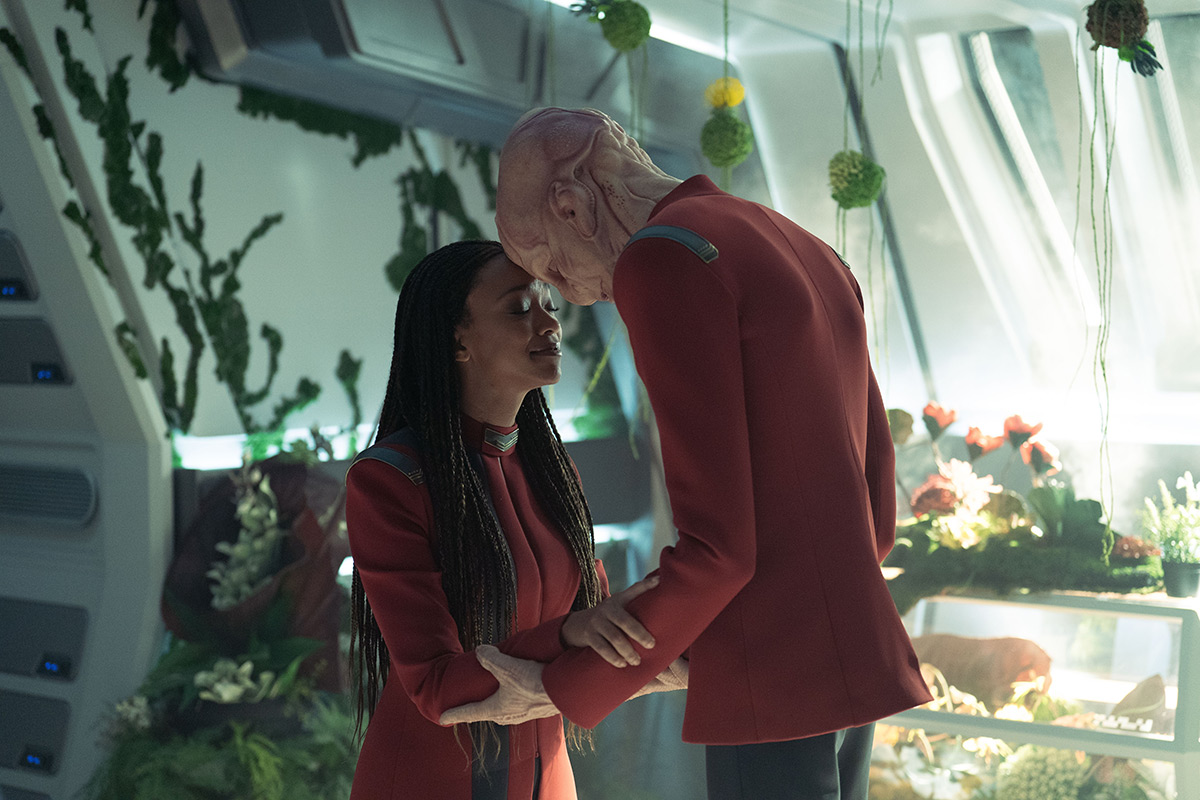
Finally, the episode ends where it began, back at Starfleet Headquarters. I’m hoping Discovery doesn’t make a habit of having the ship return to port, as it were, at the end of each episode as it only serves to make the ocean seem yet again like a very small place. But at least they’re there with good reason: Burnham needs a new first officer and, after being asked to tender his resignation, Rayner needs a second chance.
Seems like a perfect fit to me. But, um, maybe they should pick up an expert on Romulan history while they’re at it? Just a suggestion.
![]()
Star Trek: Discovery Season 5 returns with “Jinaal” on Thursday, April 11.
